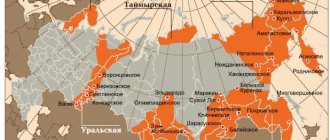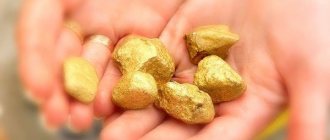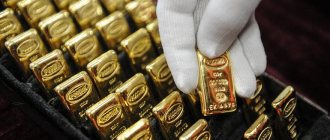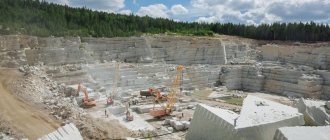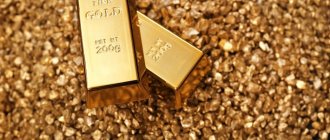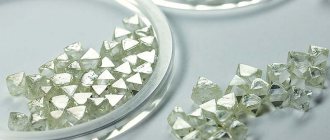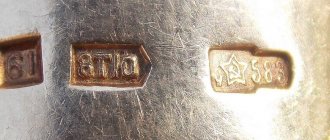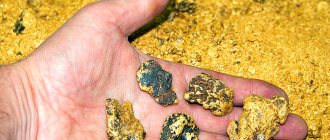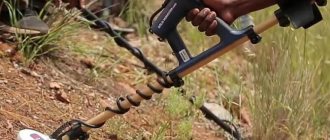Good afternoon We know a lot about the American gold rush - the unorganized mining of the precious metal by prospectors, mostly poor adventurers. Writers (Jack London, Jules Verne) and Hollywood cinema contributed to the mythologization of the gold rush in the United States. Stories about the tragic fate of the indigenous population of America - the Indians - played a role.
Gold deposits in Russia are also numerous. We have not been spared by the general obsession with wealth. The Russian gold rush lasted from the beginning of the 19th century and covered Siberia and the Far East - at that time remote, undeveloped territories.
There was a legend about Yegor, nicknamed Lesnoy, a former convict who was one of the first to begin independent mining in the Berikul River basin, but never reported where exactly he could find gold.
Where does gold come from?
Metals with an atomic mass of more than 55 units (heavier than iron), which cannot be formed inside stars, arise as a result of gamma-ray bursts - releases of energy in space during supernova explosions. Gold came to Earth with asteroids many years ago, when our planet was just being formed and had no atmosphere. Most of the heavy elements sank below the Earth's surface and formed the core.
There are few precious metals on the surface. Their main volume is located in the mantle - the substance between the earth's crust and core. In the upper layers of the mantle, a hot melt is formed - magma, which in some places penetrates the surface of the Earth. There it hardens and turns into solid rock, containing almost the entire periodic table.
Magma is heterogeneous, hardens unevenly - refractory substances coexist with low-melting substances, and the latter continue to circulate inside the solidified former. This is how gold veins are formed within the rock.
Private mining
The low profitability of gold mining does not frighten residents of the Moscow region, who in the summer turn into numerous private miners, happily spending time on the banks of large and small rivers.
For their purposes, they use simple, but time-tested and reliable mining technology. Most prospectors only need a few items to get started:
- tray;
- shovel;
- bucket;
- scoop.
The main difficulty is the main question: where to dig? Some miners dig through river sediments, while others go to quarries where sand and gravel are extracted. Once the location has been determined, you can begin to work.
Here another difficulty awaits the lover of precious metals. The prospector will have to patiently and carefully carry out the same constantly repeated movements for a long time. In general, the proverb applies to prospectors like no other profession: “Persistence and work will grind everything down.”
Classification of gold deposits
There are two types of deposits. They are divided into:
- primary, they are also radical;
- secondary - alluvial.
Indigenous
Primary deposits are the same fragments of magma ejected onto the surface of the globe. It happens that gold is present in the rock in the form of veins and nuggets, but more often it is alloyed with other elements: gold ores with copper, quartz, iron and sulfur compounds, and polymetallic alloys are common.
The main deposits of gold mined in Russia are concentrated in primary deposits.
Alluvial
Secondary deposits appeared as a result of destruction (weathering) of primary ones. Weathering refers to the impact not only of air currents, but also of water, temperature changes and even the activity of bacteria. It was alluvial deposits that were so diligently developed by amateur, lone miners.
Until the end of the 19th century, gold was mined mainly from placers - by washing (sliding), which is possible due to the relative gravity of gold. Lighter impurities were washed away with water, leaving gold sand in the washing trays, which was melted into ingots and products.
At the end of the 19th century - during the era of the birth of the scientific and technological revolution - technologies appeared that made it possible to effectively develop igneous rock. This has affected the scale of gold mining: it is believed that 60% of all gold mined in the entire history of mankind is metal produced over the past 150 years.
Techniques for clearing the “wheat from the chaff”
To improve the quality of a precious metal, one of the following techniques is used:
- leaching is a method based on the extraction of Au from complex compounds, for example, if iron sulfide minerals are present, it is necessary to heat the working medium to a certain temperature and increase the pressure (autoclaving method), impurities will be removed, and gold with this method of extraction and purification will become a solid residue ;
- electrolysis - the method is used provided that the alloy contains no more than 5% Ag impurities, when electrolysis is used, gold is dissolved, for which certain types of acids are prepared (most often hydrochloric), then the precious metal enters a special chamber, and the impurities go into another compartment;
- amalgatation - the method is based on the use of mercury, which absorbs Au particles; when their amount in the liquid metal becomes extremely high, separation occurs, which allows the precious metal to be collected, separating it from the mercury as well;
- Water washing is a method used when gold is mixed with lighter minerals.
Gold mining map
In this article I will consider only a few regions of Russia - keep in mind, there are many more, especially in the Far East, Far North and Siberia.
Deposits of the European part of the Russian Federation
The largest amount of gold was deposited in areas where magma often reached the land surface - now there are mountains and hills, like in the Urals and Magadan. Therefore, in Central Russia there is almost no search for gold.
There are some placer deposits in the Kostroma region, on the Chabra and Chashchevaya rivers, but they are unlikely to be of interest to large gold mining companies. However, this is not a hindrance for amateur enthusiasts: if you want to try to wash a couple of grams of precious metal in the river, know that this is possible.
West of the Ural Range there are only three industrial gold mining provinces:
- Dnieper-Donetsk zone;
- Karelo-Kola;
- Caucasian.
The gold mining potential of these zones is the smallest of all those located in Russia.
Deposits of the Urals and Trans-Urals
The Ural gold mining province is fourth in the Russian ranking. It is inferior to the Baikal-Vitim, Altai-Sayan and Verkhoyansk-Kolyma provinces. The development of deposits in the Urals began in the 18th century, and by the end of the 20th century there were already more than 300 mines operating here.
The gold mining industry is most interested in primary deposits, but in the Urals and the West Siberian Plain there are many placers - mainly alluvial, that is, accumulated in river beds, “alluvial deposits”. The largest of them are located in the Perm, Chelyabinsk and Sverdlovsk regions.
Deposits of Eastern Siberia
Eastern Siberia is a region of Russia rich in precious deposits. Transbaikalia has been developed since the middle of the 19th century. The largest center of gold mining has always been the Irkutsk region: the village of Bolshie Koty, modern deposits with the picturesque names Sukhoi Log and Chertovo Koryto.
Single miners were content with working in the stream with a shovel and a tray, while organized groups dug orts - underground tunnels that were eventually connected into a network. In such a mine, workers (often convicts) heated the rock from morning to night.
It was dangerous to be in the orts: despite the fortifications, tunnels and passages kept collapsing, burying people under them. No one knows how many of these mass graves have survived - the comrades of the victims erected an impromptu monument and left, refusing to develop the deadly mine.
Cartography to help
Persistent rumors that there is gold in the Moscow region and that it is not so difficult to find it received unexpected confirmation from cartographers. Not long ago, a modern map of attractions located in the Moscow region was published. The attentive eyes of fortune hunters saw on it the symbol Au between two villages of the Dmitrov region.
One of them is Protasovo, and the second is Ignatovo. Any high school student knows that a similar sign denotes an element of the periodic table, which has atomic number 79 and is a noble metal, or, more simply, gold.
For gold mining in the Moscow region, a map indicating deposits where there is at least any significant amount of gold sand is simply necessary for the prospector. It helps to weed out rumors and legends that have no basis, and direct your energy to finding truly promising places for mining the precious metal.
The most famous deposits
Sukhoi Log
Sukhoi Log is a deposit in the Lensky gold mining district (Irkutsk region). In its depths there are 2,500 tons of gold and 1,500 tons of silver (according to rough estimates). The concentration of pure precious metal in the ore is low; there are sections of the rock with a gold content of less than 1 g/t. The geological and industrial type of Sukhoi Log is a gold sulfide deposit, that is, the predominant impurities in the rock are sulfur compounds, mainly pyrite (iron pyrite). The average gold content in the ore is 2.7 g/t.
Sukhoi Log was opened in 1961 and is still being developed. Its reserves account for 15–28% (according to various sources) of all deposits in Russia.
Berezovskoe
The Berezovskoye deposit is a gold-sulfide-quartz deposit. It is located in the Sverdlovsk region (Middle Urals) and is considered one of the first discovered in Russia, standing at the origins of our gold mining. In 1748, the village of Berezovsky arose near the mine - now a satellite city of Yekaterinburg. The Berezovskoye field is being developed underground.
Vorontsovskoe
The Vorontsovskoye deposit (Middle Urals, 12 km from Krasnoturinsk) was discovered in 1985 by geologists and has a gold-arsenic-sulfide technological type. It is developed using an open-pit method - people and machines extract ore from a quarry.
Natalka
Natalka is located 390 km from Magadan, in the Tenkinsky district of the region. This is a gold-quartz deposit, the second largest resource in Russia after Sukhoi Log. The average gold content in the ore is 1.7 g/t.
The Natalka gold deposit was also discovered by geologists in the 1940s. It bears the name of Natalya, the daughter of D.T. Aseev, who discovered a gold-bearing stream at the site of future mining.
Which deposit is the largest?
The largest gold deposit in Russia is the above-mentioned Sukhoi Log. It has not yet been fully developed and has long been considered unpromising due to the fact that mining is complicated by the uneven, sometimes low, gold content of the ore. People have yet to master it.
Extraction methods
For a long period of time, starting from the end of World War II, new technologies have been regularly developed that make it possible to mine gold in large volumes and at minimal cost. Before this, rather primitive methods were used, which today are called traditional.
Today, improved methods of gold mining . We owe this to scientific progress. To increase production volumes, special equipment is used to work on a large scale.
It has become easier to mine precious metals, because modern industry offers 3 methods of gold mining:
- career;
- mine;
- draggy.
The first method is characterized by large open areas. To do this, areas are either excavated using specialized equipment or undermined. The second method is most often used. Then, with the help of machines with human participation, aurum is obtained.
Since most of the “yellow metal” is concentrated in the bowels of the earth, it is often mined in mines. Basically, people take part here, since not every mine is capable of accommodating equipment. For mining using the shaft method, you will need a drill, the length of which can reach several hundred meters. After this, elevators are installed to move people and carts. And finally, precious metals are mined.
The third method is usually classified as a separate category, since it is characterized not only by the harvesting of minerals, but also by their enrichment. Dredge mining is determined by the use of a floating mining and processing machine. And dredges are popular only in placer deposits.
Most often, in the dredging type of gold mining, pit opening is used. Its essence lies in the formation of an underwater section. At the same time, the volume of water must be quite large so that the unit can be installed in any location, extracting precious metals without hindrance.
In addition to pit opening, other methods of gold mining are known:
- dam;
- transshipment;
- inferior.
They are often combined if the scattering is unevenly distributed. However, any of the above methods negatively affects bodies of water: rivers, lakes, seas.
How and where gold deposits can be developed
In many countries of the world (Australia, Finland, some US states), the government solved the problem of private mining simply - it resolved it. All you have to do is buy a license and you’re welcome to the stream with your tray. Citizens are allowed to use what they have obtained at their own discretion.
It's different in Russia. It is almost impossible to become legalized as a gold miner, Art. 191 of the Criminal Code of the Russian Federation is in effect, and the found metal must be handed over to the state. The bill on civil liberties and the issuance of licenses has been considered in the State Duma since 2009, but has not yet been adopted.
A single miner should focus on the map of alluvial deposits, of which there are many in the Urals and Transbaikalia. There are abandoned mines, the residual deposits of which are of no interest to industrial developers. You can find gold in river basins:
- Sanarka;
- Lena;
- Bodaibo;
- Big Chanchik;
- Bom;
- Talga et al.
Also see below how gold is mined by a prospector:
A little history
Gold from the Moscow region has been mentioned in historical references since the beginning of the 19th century. The soldiers of Napoleon's army, having occupied Moscow, first of all began to inquire from the local residents where the extraordinary “golden” river was located, in which, instead of fish, gold nuggets await their catchers.
After the expulsion of Napoleon and the end of hostilities, envoys from the Russian imperial court came to Moscow. The purpose of their visit to Moscow was the same as that of the French: to learn about large gold deposits near Moscow. However, the residents of the Moscow province did not reveal their secret, and the royal envoys returned to the court with nothing.
Another outbreak of the “gold rush” occurred in the lands near Moscow before the October Revolution. The reason for it was an incident that helped a peasant from the Dmitrov region find two rather large nuggets on the banks of a small nameless river. The lucky plowman resold the find to a capital merchant. Soon after this, “top secret” maps with the designation of a gold-bearing place began to circulate around Moscow.
In response, many Moscow residents succumbed to the excitement and decided to try their luck with a prospecting tray in their hands. Even the famous master of reporting, Vladimir Gilyarovsky, succumbed to the general excitement, and went along with everyone else to catch their luck. Moscow guidebooks responded to the increased demand and began to publish data that there really are gold deposits near the village of Iksha, and they can be found in:
- gold placers;
- alluvial boulders of glacial origin.
The baton of general excitement was picked up by local newspapers, which began publishing articles with tempting, action-inducing headlines:
- "Klondike near Moscow";
- "Russian California";
- "Golden River"
The successful entrepreneur Ponomarev was not at a loss at the right moment. In the wake of popular interest, he created a joint-stock company with the goal of organizing gold mining on an industrial scale. Very respectable people of that time became members of the society. However, their hopes for quick enrichment were not realized.
The gold rush died out as suddenly as it started. And the reason for this was not at all the absence of the sought-after gold in the rivers near Moscow.
Industrialists did not have the technology to make metal mining economically interesting. At that time it simply did not exist.
